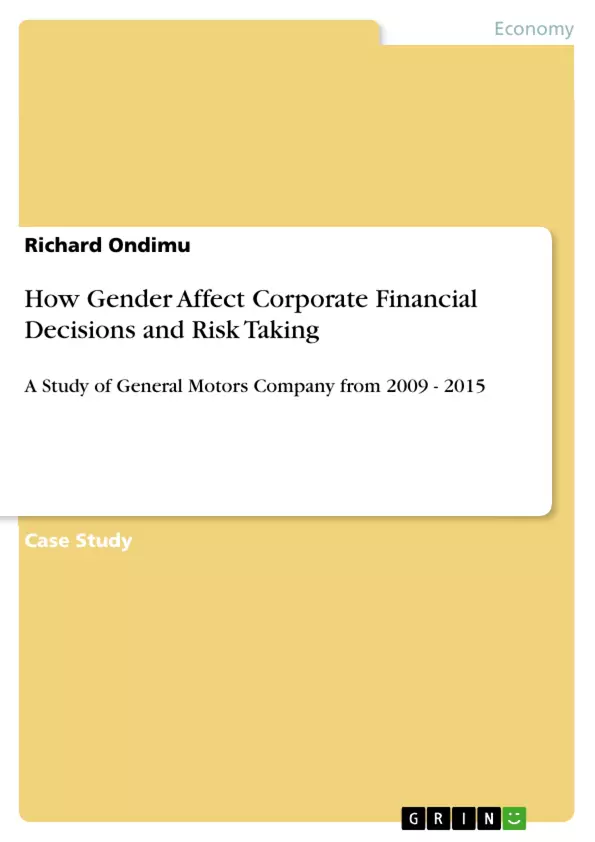It is now becoming increasingly evident that gender plays a vital role in investment and financing decisions of many organisations today as men and women tend to behave and act differently. Women are generally perceived to be detail-oriented, keen and sceptical in decision making relative to their male counterparts who are more risk tolerant. This study examines a number of empirical studies and other relevant literature to help justify as to whether or not, there is a relationship between gender, corporate financial decisions and risk taking.
Using General Motors (GM-US), a company that experienced a CEO and Board Chair changeover from male to female in early 2014 and 2016 respectively as a case study, the essay examines measures like leverage, solvency, M&A activities, and other metrics that can directly be attributed to CEO/Board chair’s decisions and how these decisions alter the company’s risk profile in the period prior to and after the transition.
Inhaltsverzeichnis (Table of Contents)
- Introduction
- Literature Review
- Gender-Based Behavioural Differences on Risk Perception
- Effects of CEO Changeover (from Male to Female or Vice Versa) on Corporate Risk-Taking
- Effect of Gender Differences in Corporate Financial Decision Making
- A Case Study of General Motors (GM) Limited
- Background Information
- The Case Evaluation Criteria
- Leverage Position/Solvency Position
- Altman's score measure of bankruptcy
- GM's Mergers and Acquisition Activities
- Conclusion
- References
- Appendices
- Appendix I: Formulas and Other Footnotes
- Appendix II: Computed Ratios and Extracts
Zielsetzung und Themenschwerpunkte (Objectives and Key Themes)
This study aims to investigate the relationship between gender and corporate financial decisions and risk taking. Using General Motors (GM) as a case study, the research analyzes the company's leverage, solvency, mergers and acquisitions activities, and other financial metrics before and after the transition from a male to a female CEO and Board Chair in 2014 and 2016 respectively.
- Gender-based behavioral differences in risk perception
- Impact of CEO gender transition on corporate risk-taking
- Influence of gender on corporate financial decision making
- Analysis of financial performance indicators in relation to CEO gender
- Case study of General Motors (GM) to assess the impact of gender on corporate risk-taking and financial decisions
Zusammenfassung der Kapitel (Chapter Summaries)
The Introduction sets the context by highlighting the increasing presence of women in corporate leadership roles and the potential impact of gender on financial decision-making. It also outlines the study's focus on General Motors as a case study.
The Literature Review summarizes existing research on gender and corporate finance. This section explores three key strands of research: gender-based behavioral differences in risk perception, the effects of CEO gender transition on corporate risk-taking, and the influence of gender differences in corporate financial decision making. It reviews various studies, including Byrnes, et. al., (1999), Barber and Odean (2001), Weber, et. al., (2002), Faccio, et, al., (2016), Palvia, et.al., (2014), Farrell and Hersch (2005), and Adams and Funk (2012).
Schlüsselwörter (Keywords)
This study focuses on the relationship between gender, corporate financial decisions, and risk taking. Key terms and concepts include gender differences, corporate financial decision-making, risk perception, CEO gender transition, leverage, solvency, mergers and acquisitions, and the case study of General Motors (GM).
- Quote paper
- Richard Ondimu (Author), 2016, How Gender Affect Corporate Financial Decisions and Risk Taking, Munich, GRIN Verlag, https://www.grin.com/document/358716



